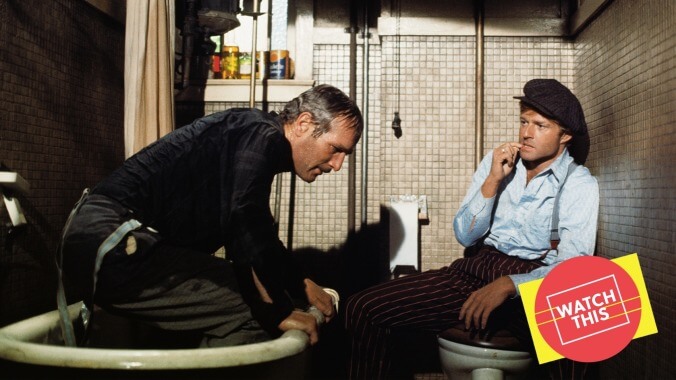It only took two movies for Newman and Redford to become an iconic onscreen duo

Watch This offers movie recommendations inspired by new releases, premieres, current events, or occasionally just our own inscrutable whims. This week: With Man Of Steel costars Kevin Costner and Diane Lane appearing together again in Let Him Go, we’re looking back at other onscreen star reunions.
The Sting (1973)
For viewers of a certain age, it’s hard to think of Paul Newman without Robert Redford coming to mind—and vice versa. The two are forever linked, like Astaire and Rogers or Tracy and Hepburn. Yet they only co-starred in two movies, the second of which made little effort to replicate the actors’ unique dynamic in the first. Indeed, Newman’s presence in The Sting would have seemed improbable to anyone who’d read an early draft of David S. Ward’s screenplay—his character, Henry Gondorff, was described as heavily overweight and conceived very much as a supporting role, and Johnny Hooker, the part Redford plays, served as the story’s sole protagonist.
Newman was in dire need of a hit, however, following several box office flops (anyone remember WUSA?), and reuniting Butch Cassidy with the Sundance Kid—slimming Gondorff down physically, while beefing him up into an additional lead—surely seemed like the easiest way to print money. To say that it worked would be putting it mildly: Not only did The Sting win the Best Picture Oscar for 1973, but it’s still the 21st-highest-grossing movie in history if you adjust for inflation, having taken in the 2020 equivalent of $835 million. That’s a lot of Newman and Redford fans.
Again, though, the film barely takes advantage of audiences’ desire to see these two actors’ easy, sparring rapport. They don’t share many scenes, in part because the byzantine plot often requires Gondorff and Hooker to act separately even though they’re working toward the same end. Their plan: fleece Doyle Lonnegan (Robert Shaw), an Irish mobster whose goons murder Hooker’s partner (Robert Earl Jones, father of James) at the beginning of the movie. Hooker wants revenge, and Gondorff, a legendary con man who’s become a drunken has-been, seeks redemption; neither of these character arcs amounts to much, though, and both performances lean on simple charisma.
What makes The Sting so much fun is the con itself, which takes up practically the film’s entire running time, divided into multiple stages (“The Hook,” “The Tale,” “The Shut-Out,” etc.) and chronicled in exacting detail. Ward based his script on actual swindles that he’d read about, finding just the right balance between keeping the viewer apprised of what’s going on (more or less) and reserving a few twists to be sprung along the way. For a contemporary viewer, the scheme’s basic idea can be tricky to understand: It was archaic even in 1973, as the film—famously scored to Scott Joplin’s ragtime compositions, most notably “The Entertainer”—takes place in 1936; way back then, the results of horse races were often announced after the fact via teletype, making it possible, albeit just barely, for someone to wager on a race that had already produced a winner minutes earlier.
By the end, though, it all makes sense, and both stars look truly iconic decked out in Edith Head’s period costumes and riding around in vintage automobiles. Newman gets to have the most fun, as Gondorff’s function in the con involves posing as an obnoxious Chicago bookie (dubbed “Shaw,” which can be a mite confusing given that he’s usually interacting with Robert Shaw) and goading Lonnegan into placing an enormous bet at the phony off-track location created by him, Hooker, and their sizable crew. Redford does his ’70s brash doofus routine to superb effect, and succeeds in selling the key element that has to work in order for both the sting and The Sting to come off as planned.
It’s not spoiling anything to reveal that the movie concludes with its two lead actors walking off into the distance, side by side, as an old-timey iris effect isolates them within darkness. Newman would live for another 35 years, but he and Redford, after two era-defining smashes, never worked together again. It didn’t matter. That was enough.
Availability: The Sting is currently streaming for free (with ads) on Peacock. It’s also available for digital rental and/or purchase via iTunes, Amazon, YouTube, Fandango Now, Vudu, Redbox, DirecTV, and AMC Theatres On Demand.